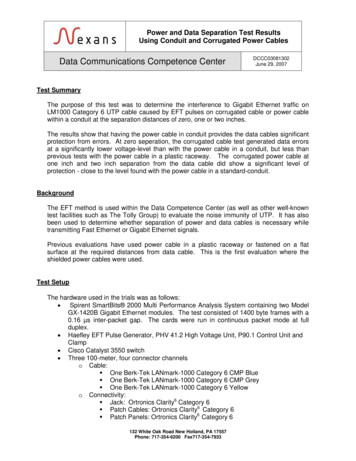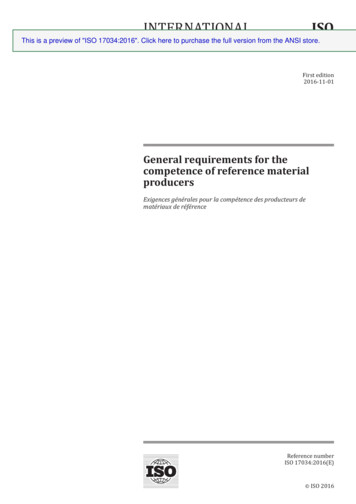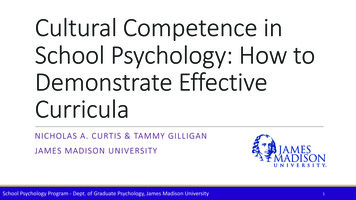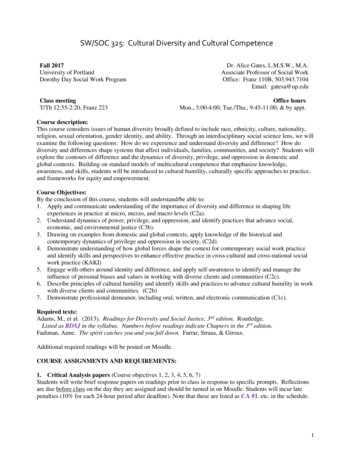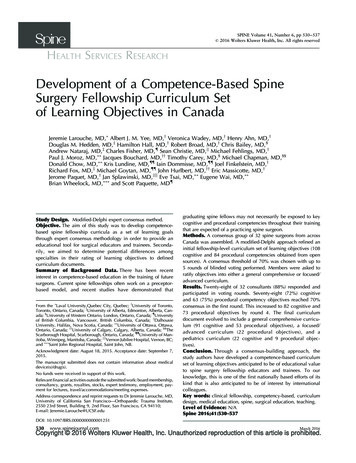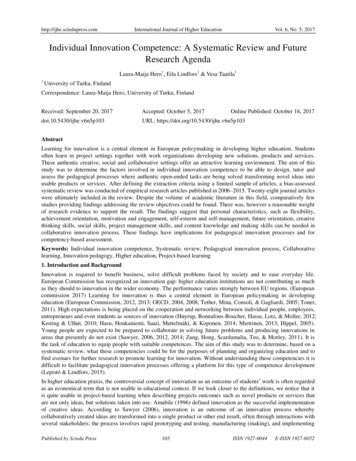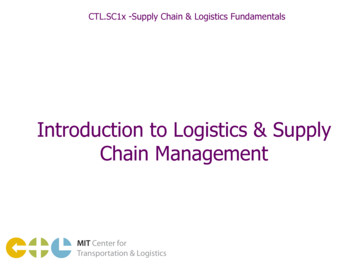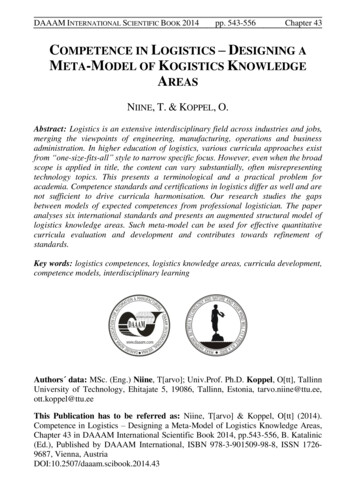
Transcription
DAAAM INTERNATIONAL SCIENTIFIC BOOK 2014pp. 543-556Chapter 43COMPETENCE IN LOGISTICS – DESIGNING AMETA-MODEL OF KOGISTICS KNOWLEDGEAREASNIINE, T. & KOPPEL, O.Abstract: Logistics is an extensive interdisciplinary field across industries and jobs,merging the viewpoints of engineering, manufacturing, operations and businessadministration. In higher education of logistics, various curricula approaches existfrom “one-size-fits-all” style to narrow specific focus. However, even when the broadscope is applied in title, the content can vary substantially, often misrepresentingtechnology topics. This presents a terminological and a practical problem foracademia. Competence standards and certifications in logistics differ as well and arenot sufficient to drive curricula harmonisation. Our research studies the gapsbetween models of expected competences from professional logistician. The paperanalyses six international standards and presents an augmented structural model oflogistics knowledge areas. Such meta-model can be used for effective quantitativecurricula evaluation and development and contributes towards refinement ofstandards.Key words: logistics competences, logistics knowledge areas, curricula development,competence models, interdisciplinary learningAuthors data: MSc. (Eng.) Niine, T[arvo]; Univ.Prof. Ph.D. Koppel, O[tt], TallinnUniversity of Technology, Ehitajate 5, 19086, Tallinn, Estonia, tarvo.niine@ttu.ee,ott.koppel@ttu.eeThis Publication has to be referred as: Niine, T[arvo] & Koppel, O[tt] (2014).Competence in Logistics – Designing a Meta-Model of Logistics Knowledge Areas,Chapter 43 in DAAAM International Scientific Book 2014, pp.543-556, B. Katalinic(Ed.), Published by DAAAM International, ISBN 978-3-901509-98-8, ISSN 17269687, Vienna, AustriaDOI:10.2507/daaam.scibook.2014.43
Niine, T. & Koppel, O.: Competence in Logistics – Designing a Meta-Model of Lo.1. IntroductionLogistics is an extensive field reaching across sectors, industries and widelyvarying responsibilities and job descriptions. Over decades, logistics has evolved intoan interdisciplinary concept across the fields of natural and social sciences, mergingthe viewpoints of engineering and business administration. In both domains, thescope of topics covered by logistics has expanded in time. Recently, integratedtreatments of manufacturing, technology design and logistics have seen majordevelopments, further reinforcing the engineering aspect of logistics.Among such variety and complexity, the core concept of “logistics” remains atthe heart of research, monographs, university curricula and competence models.However, the more detailed explanation about the component areas of logistics onewould research, the more there are disagreements and mismatches in approaches.This is to some extent taking place already on the definition level, but much more sowhen detailed models of competences and knowledge areas of logistics professionalsare concerned.In terms of function-specific niches inside logistics, there is relatively lessdebate. Areas such as warehouse operations or transport planning have their ownstandards and certification options and universities, if they desire, can build theircurricula with more detailed and clear focus. The more interdisciplinary the approachaims to get, the more difficulties for scope it presents. For example, manufacturinglogistics support merges production with inventory management, but is alsointertwined with purchasing, material handling and ICT topics.In terms of undergraduate programs, the approach applied by the majority is stillgeneric “logistics” without more specific focus. In all these cases the competence thatshould be acquired is less clear due to two main factors. One is the wide range oftopics that modern logistics entails per se, forcing difficult choices upon curriculadesigners. Secondly, various international certification and competence modelapproaches disagree to certain extent among themselves, which means curriculaboards are getting mixed messages. In our view, the problem lies in the lack of clarityand harmony across competence standards, which is required for effective curriculadevelopment. This paper aims to contribute to reducing the problem by presenting asynthesised meta-model of logistics professional’s knowledge areas. The goals of ourpaper are twofold: to identify gaps between standards of logistics competences and fill them; to create an integrated tool for “short-cut knowledge-area analysis” of existingcurricula as well as developing and positioning new ones.The structure of this chapter is the following. We start out briefly presentingsome relevant points from the literature. Then we focus on the area of competencemodels in logistics and present a comparison of selected renowned models. Thecreation and configuration process of our own model is then explained. We alsopresent initial results from pilot-testing our model against a selection of curriculawhich gave feedback to the model. We conclude with brief discussion of implicationsand outlining further actions.
DAAAM INTERNATIONAL SCIENTIFIC BOOK 2014pp. 543-556Chapter 432. Literature reviewGlobalisation and changes in the society keep labour market situation everevolving (Jirincova & Leicherova, 2012). Knowledge is a limited resource andimportance of knowledge as a driving force of innovation and economic growthworldwide is increasing significantly (Tekic et al, 2013; Sorak & Dragic, 2013). Thisprioritises distinguishing between average and excellent employees and thedevelopment of performance (Krajcovicova et al, 2012) which in turn effects thecompetences required from students (Pupavac, 2011). The exact responsibilities oflogisticians has been much discussed (Gudehus & Kotzab, 2009; Schönsleben, 2007).The definition often offered explains logistics via activities that facilitate thecoordination of supply and demand in creating time and place utility, which leavesroom for various professional interpretations (Simchi-Levy et al 2005, Dinitzen &Bohlbro, 2010; Erturgut & Soysekerci, 2011).Modern logistics is understood as interdisciplinary concept and as such,interfaces with other business functions, as well as to other areas of engineering areabundant. Most textbooks of logistics present some form of a model of thecomponents (David & Stewart, 2010; Farahani et al, 2011). Perhaps one of the moststructured approaches to logistics decision areas has been put forward by Langevinand Riopel (2005) in presenting a structure of 48 decision areas across the levels ofstrategic planning, physical facility network and operations.While such approaches offer insight, they are not specific enough to use asdirect input for curricula. Furthermore, specific treatments are not internationallyagreed upon. Therefore this paper directs attention towards logistics competencestandards of wider recognition in hopes that such platforms offer more feasibleharmonisation. As far as we know, specific and detailed analysis of variouslogistician competence models with curriculum development focus has not beencarried out before.3. Methodology3.1 Input selection criteriaThe criteria for selecting logistician competence models and occupationalstandards to be included in our study were the following:1. The model has to focus on “logistics” with a relatively broad view. This meansthat a model of “distribution and logistics management” would fall into selectionas distribution is an integral part of logistics, whereas a model of purely“warehouse management” (such as certification offered by InternationalWarehouse Logistics Association) was not included as logistics is in manydimensions broader than warehousing operations. Another model left out wasCertified Logistics Technician (CLT) certification, as it focuses exclusively ontechnical competencies of front-line material handling and distribution workers.2. Models focusing purely on “supply chain management” would be excludedstemming from the conceptual understanding that logistics is, though similar, a
Niine, T. & Koppel, O.: Competence in Logistics – Designing a Meta-Model of Lo.distinct concept, at least in terms of academic treatments of professionalcompetences. In our view contrasting logistician and supply chain managercompetence models is worthy of separate study and including this dimensionhere would obfuscate focus. The topic is controversial. There are examples oflogistics organisations that certify supply chain managers, such as SCM-PROcertification by Confederation of Indian Industry Institute of Logistics.3. The model has to describe logistician knowledge areas on professional levelsuitable for comparison against university or college curricula. Somecertification programs strictly require college diploma or degree while others aremore flexible, suggesting a combination of work life experience and additionalmodular training. Some models reference European Qualifications Framework(at least level 5 was required to be included) yet others don’t reference therelated education level at all. Models clearly focusing on lower positions wereleft aside.4. The model must have significant international recognition. Qualificationstandards of seemingly national reach only were excluded.5. The model must have clear structure in detailing applicable skills andknowledge areas. For that reason, we did not include Certified LogisticsProfessional CLP certification by The Logistics and Supply Chain ManagementSociety, among others, as their certification process is built around a scoringcalculator of various career-related achievements, but not on specificcompetences. Their understanding of the reach of logistics is represented by asingle sentence, which leaves the system flexible, but extremely subjective.Information on models to study was readily available on the internet.3.2 Selected input - relevant competence modelsAll considered, it appeared adequate to limit this research with 6 models, whichwas deemed sufficient to give plentiful ingredients to our meta-model: Distribution and logistics managers’ competency model by The Association forOperations Management (APICS, 2014); Certified in transport and logistics (CTL) by American Society of Transportationand Logistics (AST&L, 2014); Demonstrated master logistician (DML) and Certified master logistician (CML)by The International Society of Logistics (SOLE, 2005); International Diploma in Logistics and Transport by Chartered Institute ofLogistics and Transport (CILT, 2006); Logistics professional by European Logistics Association (ELA, 2014); Certified International Trade Logistics Specialist (CITLS) by InternationalTrade Certification (IIEI, 2014).The Association for Operations Management APICS is one of the more widelyknown international bodies in logistics. Their model consists of two classes ofcompetencies: foundational and profession-related. While the latter expands into atree of knowledge areas in “operations management” and “distribution and logistics”,the former is mostly structured around personality traits, general skills and attitudes.
DAAAM INTERNATIONAL SCIENTIFIC BOOK 2014pp. 543-556Chapter 43In the view of using APICS model as benchmark for curricula, mostly onlyprofession-related topics would be directly applicable. While it is, of course, relevantto develop traits such as integrity, continuous learning and problem solving ability inany industry-focused training program, the presence of such aspects are largely notidentifiable from curricula explicitly. Such aspects are essential for curriculum selfevaluation, but difficult to evaluate from outsider’s perspective and this is the reasonwhy our model describes “knowledge areas” not competence, which is a widerconcept. Our focus is specific topics which are directly comparable against curriculacontent and measurable on the level of course titles and descriptions. Keeping that inmind, some items under “academic foundational competencies” in APICS model,such as sections “enterprise economics” and “materials management” were applicablefor our research purposes.American Society of Transportation and Logistics offers multiple levels ofcertification options: an entry-level oriented “global logistics associate” (GLA), acentral and probably most popular “certified in transport and logistics” (CTL) andmore exclusive senior-level “distinguished logistics professional” (DLP). CTLpresents a flexible framework of three compulsory modules (transport economics,logistics management, international transport and logistics) and three requiredelective modules of seven (general management principles, lean logistics, logisticsanalysis, supply chain strategy, logistics finance, supply chain management andcreative component). To qualify as CTL, an individual must have earned anundergraduate degree or have at least three years of industry experience. It is worthnoting that different to some certification programs, AST&L also lists universities,the coursework of which is directly counted towards certification.The International Society of Logistics, with presence in over 50 countries,approaches the topic with more emphasis towards technologies, (being originally TheSociety of Logistics Engineers) and promotes a balance between logisticsmanagement business methods on one side and engineering and industrial processeson the other. SOLE recognition system has five steps: demonstrated logistician,demonstrated senior logistician, demonstrated master logistician, certified masterlogistician (CML) and certified professional logistician (CPL). Each step on thecareer path imposes logistics job performance and continuing education requirementsas well as additional lists of related functional skills and enabler skills training areas.Workplace experience and education degree and coursework requirements areinterrelated and flexible – a defined amount of courses needs to be passed for everyrecognition level from a large list of electives. According to SOLE, applicants withmaster’s degree are invited to CML levels directly. SOLE suggest a model of typicaleducational areas appropriate to logistics designation programs, which is built aroundfour pillars: systems management, systems development and design, acquisition andproduct support and distribution and customer support.The UK-based Chartered Institute of Logistics and Transport (CILT), withmembers in 30 countries, offers three levels of certification: International Certificatein Logistics and Transport (level 3 in EQF), International Diploma in Logistics andTransport (level 5 in EQF) and International Advanced Diploma in Logistics andTransport (level 6 in EQF i.e. “degree level”). According to the diploma guide: “TheDiploma is aimed at those already working in the industry/sector at a middlemanagement level and who wish to develop a strategic view of logistics and transport
Niine, T. & Koppel, O.: Competence in Logistics – Designing a Meta-Model of Lo.operations”. The course content is divided into six modules: logistics operations,resources, transport economics and finance, logistics and supply chain, inventory andwarehouse, and finally passenger transport. Advanced diploma adds a layer of fiveknowledge areas relating to strategic performance management. The range of topicsis extensive on both levels, but are intended to be completed in only 360 hours.A similar structure of three levels is suggested by European LogisticsAssociation: supervisory and operational management of logistics (EQF level 4),senior management of logistics (level 6), and strategic management of logistics (level7). ELA is a federation of 30 national organizations, situated in Central and WesternEurope. The mission of ELA is to offer certification that follows industry trends andis suitable for international evaluation, training and recruitment. Both level 4 andlevel 6 ELA standards consist of four key skill areas: business principles, logisticsdesign, supply chain and logistics planning and execution, with latter furtherexpanding into transport, warehousing, customer service and sourcing topics.IIEI International Trade Certification has defined altogether 10 standards forvarious positions concerning international trade operations. While some of them areclearly too narrow to be used in this research, such as Certified International FreightForwarder, the Certified International Trade Logistics Specialists (CITLS) suggests abroad range of knowledge areas, which IIEI calls “an in-depth synopsis of SupplyChain Management concentrating on the exporting/importing environment”. TheCITLS model is essentially a long list of over 30 topics as specific knowledge areasexpected from logistics specialist operating in international trade.3.3 Logistics knowledge areas - model configurationOur process of research steps undertaken along with results from each steps arepresented on Fig. 1 below.Fig. 1. Implemented research process and outcomesEven without delving deep into our selection, it was clear that models were farfrom describing the same scope. Being perfectly competent to be certified by any oneof these models would not automatically assume certification success according toothers. The models differ in scope, in structure, in the level of detail described and inthe approach used to describe the details, whether from the viewpoint of knowledgeareas (i.e. understands, is knowledgeable about.) or skills (i.e. skilled in performing,
DAAAM INTERNATIONAL SCIENTIFIC BOOK 2014pp. 543-556Chapter 43evaluates, identifies, manages, demonstrates etc.). The extent of differences referredin step 2 are in more detail demonstrated in the following section.To merge the knowledge areas of all the models, it would be possible to use anyone structure as a basis and “fill in the gaps”. However, we felt that none of thestructures were perfect in terms of classifying knowledge areas directly from teachingviewpoint rather than performance-in-workplace view that most standards are basedon. Hence heavy restructuring of topic divisions appeared unavoidable. Careful toavoid bias, we split models into component fragments, merged the fragment poolsand sorted the elements into reasonable structure for curricula analysis. The initialpool was a notable mess which further demonstrated substantially different ways topresent the mind of a logistician.While step 3 was purely mechanical, steps 4 and 5 required thoughtfulconsiderations, keeping in mind both the integrity as well as practical usability of theemerging model. To demonstrate the application of our model, pilot-testing was doneand the findings from step 6 were used as feedback to further refine it.The principle of the model is simple. It consists of 20 knowledge areas, witheach section containing 9-12 elements that should belong to logistician’s training.The model is sizeable and presented in the appendix. For example, section“manufacturing process and technologies” includes 11 elements, items such as“manufacturing capacity planning”, “CAD-CAM systems” and “quality assurance”.While they do not belong to the heart of logistics, the interfaces are still relevant. Foreach item, the evaluation can have three outcomes: 1) it is explicitly embedded in thecurriculum; 2) inclusion of the topic in the curriculum appears indirect, with moredistant wording, as a possible component under a more general heading or if a widertopic field forms only a small part in one course (this mitigates the case whenpublicly available data is less than perfect); 3) there is no indication that the topic isincluded in the curriculum. Mathematically it is just 1.0, 0.5 or 0 and the averagerating across each of the 20 sections is finally what is measured. This means, for eachcurriculum analysed, we can identify to what extent is the program able to fill eachsection. In percentage values, each curriculum is represented by a vector CURi.CUR i (a1, a2 . a20)(1)In (1), ax is identified coverage of analysed curriculum o
demonstrated senior logistician, demonstrated master logistician, certified master logistician (CML) and certified professional logistician (CPL). Each step on the career path imposes logistics job performance and continuing educati


